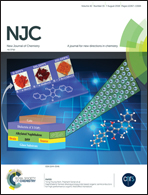A new nanosensor for the chiral recognition of cysteine enantiomers based on gold nanorods†
Abstract
An easy-to-use, fast and highly selective method, which used unmodified gold nanorods (GNRs) as a chiral nanosensor for the chiral recognition of cysteine (Cys) enantiomers, has been developed in this work. Under the optimized conditions, L-Cys caused GNRs aggregation, and the absorbance decrease of GNRs at a wavelength of 650 nm was 0.601. However, the GNRs were almost monodispersed and the absorbance decrease was only 0.289 for D-Cys. The combined assay process with the optical rotation of GNRs, and the chiral recognition phenomenon could be assigned to the fact that L-Cys induced the end-to-end assembly of GNRs through crosslinking agent Cu2+ ions. The detection limit of this method for L-Cys was 0.325 μM. The relative standard deviation (RSD) was 1.5% for trace L-Cys, which indicated that the method presented good precision for the analysis of trace L-Cys in solution samples. Futhermore, we demonstrated that the nanosensor possessed high selectivity for the chiral recognition of Cys enantiomers. The response of GNRs (ΔALD) to Cys enantiomers was 7.8 times to tryptophan (Try) enantiomers, and 9.2 times to phenylalanine (Phe) enantiomers. In our perception, the assay showed new opportunities for efficient enantiosensing strategies.



 Please wait while we load your content...
Please wait while we load your content...